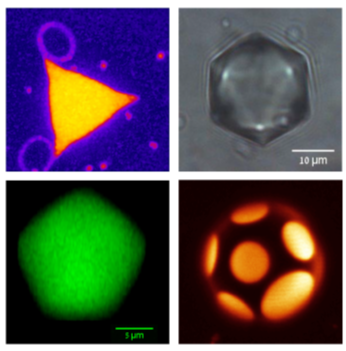25/10/2021 - 13:00 - 12:00
Add To Calendar
2021-10-25 12:00:00
2021-10-25 13:00:00
קולוקוויום 25.10.2021
Self-faceting of nano- to yocto- liter liquid droplets:
from fundamental topology to nanotechnological applications
Eli Sloutskin
Physics Dept. and Institute of Nanotechnology & Advanced Materials, Bar-Ilan University
Contrary to everyday experience, where all liquid droplets assume rounded, near-spherical shapes, the temperature-tuning of liquid droplets to faceted polyhedral shapes and to spontaneous splitting has been recently demonstrated in oil-in-water and water-in-oil emulsions1-2. These effects occur in a wide range of oil:surfactant combinations, for broad temperature ranges, and in droplets of sizes spanning an incredible 13 decades in volume, from nano- to yocto- liters, suggesting that these phenomena may play a role in a wide range of industrial technologies, where emulsions are employed. Furthermore, droplets’ solidification enabled the formation of icosahedral (and other complex-shape) colloidal and nano- particles, unachievable by any other method. However, the mechanism driving these surprising self-faceting phenomena was recently subject to a significant scientific controversy2.
Our recent experiments, employing simple linear n-alkanes and water-soluble ionic and non-ionic surfactants, have resolved the fundamental mechanism driving these phenomena1,3. In particular, we have demonstrated that the effect is driven by a few-nm thick monolayer interfacial crystal, self-assembled at the surface of the liquid droplets. This monolayer’s closed-surface topology controls the precise shapes adopted by the droplets. Similar mechanisms are suggested to play a fundamental role in shape formation in a wide range of biological systems: from viruses to living organisms.
Furthermore, taking benefit of crystalline monolayers’ self-assembly on surfaces of these droplets, we decorate the droplets by precisely self-positioned micro- and nano- particles and molecules, opening new routes towards the self-assembly of complex higher-hierarchy structures.
[1] S. R. Liber et al., JACS 142, 8672 (2020); Guttman et al., PNAS 113, 493 (2016).
[2] N. Denkov et al., Nature 528, 392 (2015).
[3] S. Guttman et al., Nano Lett. 19, 3161 (2019).
Seminar Abstract (PDF)
חדר הסמינרים המחלקתי (חדר 112)
Department of Chemistry
chemistry.office@biu.ac.il
Asia/Jerusalem
public
מיקום
חדר הסמינרים המחלקתי (חדר 112)
Self-faceting of nano- to yocto- liter liquid droplets:
from fundamental topology to nanotechnological applications
Eli Sloutskin
Physics Dept. and Institute of Nanotechnology & Advanced Materials, Bar-Ilan University
Contrary to everyday experience, where all liquid droplets assume rounded, near-spherical shapes, the temperature-tuning of liquid droplets to faceted polyhedral shapes and to spontaneous splitting has been recently demonstrated in oil-in-water and water-in-oil emulsions1-2. These effects occur in a wide range of oil:surfactant combinations, for broad temperature ranges, and in droplets of sizes spanning an incredible 13 decades in volume, from nano- to yocto- liters, suggesting that these phenomena may play a role in a wide range of industrial technologies, where emulsions are employed. Furthermore, droplets’ solidification enabled the formation of icosahedral (and other complex-shape) colloidal and nano- particles, unachievable by any other method. However, the mechanism driving these surprising self-faceting phenomena was recently subject to a significant scientific controversy2.
Our recent experiments, employing simple linear n-alkanes and water-soluble ionic and non-ionic surfactants, have resolved the fundamental mechanism driving these phenomena1,3. In particular, we have demonstrated that the effect is driven by a few-nm thick monolayer interfacial crystal, self-assembled at the surface of the liquid droplets. This monolayer’s closed-surface topology controls the precise shapes adopted by the droplets. Similar mechanisms are suggested to play a fundamental role in shape formation in a wide range of biological systems: from viruses to living organisms.
Furthermore, taking benefit of crystalline monolayers’ self-assembly on surfaces of these droplets, we decorate the droplets by precisely self-positioned micro- and nano- particles and molecules, opening new routes towards the self-assembly of complex higher-hierarchy structures.

[1] S. R. Liber et al., JACS 142, 8672 (2020); Guttman et al., PNAS 113, 493 (2016).
[2] N. Denkov et al., Nature 528, 392 (2015).
[3] S. Guttman et al., Nano Lett. 19, 3161 (2019).
Seminar Abstract (PDF)




